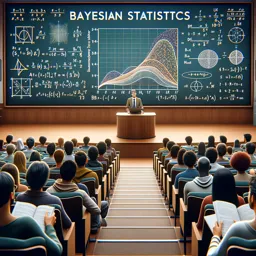Bayesian statistics is a method of probability and inference centered on updating beliefs as new evidence becomes available. Unlike classical (frequentist) statistics, it incorporates prior knowledge or opinions into the analysis, refining estimates progressively with more data. This approach is particularly useful when data are scarce or prior information is important.
The Core of Bayesian Thinking: Bayes’ Theorem
Bayes’ theorem mathematically formalizes how to revise probabilities based on new evidence:

- Prior Probability: Initial belief before new data.
- Likelihood: Probability of observed data given the hypothesis.
- Evidence: Total probability of the observed data across all hypotheses.
- Posterior Probability: Updated belief after considering new evidence.
Priors and Posteriors
Bayesian methods are flexible in using prior knowledge:
- Priors come from past studies, expert opinions, or subjective judgments and represent beliefs before current data.
- Posteriors are the updated beliefs after incorporating new data, reflecting a refined probability distribution for the parameter of interest.
Applications of Bayesian Statistics
Bayesian techniques are applied broadly, including:
- Medical research: Updating disease probabilities with test results and prior prevalence.
- Machine learning: Creating evolving probabilistic models based on incoming data.
- Forecasting: Merging expert opinions with new information for improved risk evaluation.
Advantages and Limitations
- Advantages: Incorporates prior knowledge, manages small datasets well, and offers intuitive uncertainty interpretations.
- Limitations: Selecting an appropriate prior can be subjective and challenging; complex models often demand advanced computational resources.
Conclusion
Bayesian statistics offers a powerful, logical framework for reasoning under uncertainty by continuously adapting beliefs in light of new information. It equips practitioners with practical tools for prediction, diagnosis, and decision-making.

























